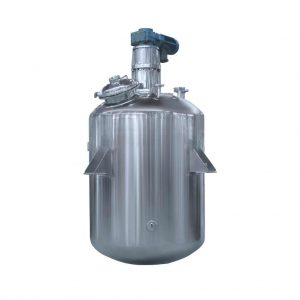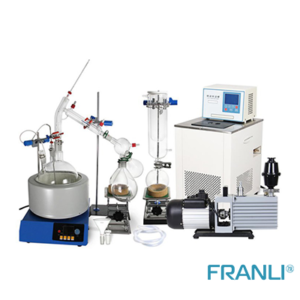Home » Hot selling laboratory reactor
Hot selling laboratory reactor
laboratory reactor
Details of Lab Reactor
- Using the latest reaction technology
- It has high temperature resistance, corrosion resistance, and high durability.
- Heating methods include steam, electric heater, high temperature heat transfer oil
- Using jacket, half pipe, fan coil, and other structures
Application: Chemicals, pharmaceuticals, dyes, pesticides, petroleum, food additives, etc.
The user needs to master the application knowledge in the process of using the laboratory reactor, according to the needs of different process conditions, the structure design and parameter configuration of the container design conditions, process, testing, and manufacturing, testing needs to be based on the relevant technical standards to achieve the heating and evaporation of the process requirements, cooling and low-speed proportioning reaction function.
The characteristics of the laboratory reactor
1. The laboratory reactor has the advantages of high-temperature resistance, corrosion resistance, and high production capacity.
2. The kettle body of the laboratory reaction kettle is composed of a reaction vessel, agitator and transmission system, cooling device, safety device, heating furnace, etc.
3. Volume specification: 0.25l-5l, design pressure: 0-35mpa, operating temperature: 450c, stirring speed: 0~100rpm step-less speed regulation.
4. The laboratory reaction kettle adopts a fast-open structure, which has functions such as the lowering of the kettle body and the pouring mechanism.
5. The components of the laboratory reactor are reasonably arranged, the structure is compact, and the installation and operation are extremely convenient.
6. The laboratory reactor is made of hastelloy b2 material, and all contact materials are hastelloy, including the brine of each valve.
7. The safety valve adopts the bursting diaphragm, the error of the bursting value is small, the instantaneous exhaust speed is fast, and it is safe and reliable.
8. It adopts a needle valve, reciprocating opening, and closing structure, and durable and reliable sealing. All kinds of valves are installed reasonably, with no leakage or dead angle. The supply port is equipped with a hose valve, which is convenient for supplies. The opening of the kettle cover is as shown in the design drawing.
9. A spare valve is installed on the reaction kettle, which can adjust the pressure of 1~5mpa and control the pressure in the kettle to balance it.
10. To reduce the time of opening the cover and facilitate the discharge of materials, the material discharge valve is used as the lower expansion valve, so that there is no dead angle for stirring.
The use of a laboratory reactor
Laboratory reactors are widely used in petroleum, chemical, rubber, pesticide, dye, medicine, food, and other production users and research on various scientific research and experimental projects, including hydrolysis, neutralization, crystallization, distillation, evaporation, storage, hydrogenation, polymerization, condensation, heating coordination, and heating coordination are also often used in the development of new products by universities, scientific research institutions, and enterprises.
Classification of laboratory reactors
The classification of laboratory reactors includes stainless steel reactors, single-layer glass reactors, double-layer glass reactors, and triple-layer glass reactors.
In the reaction process of the laboratory reactor, the material is a colorless or light yellow transparent, brittle, almost odorless, tasteless plate or coarse powder. 5-10 times the amount of cold water expansion, soluble in hot water, glycerol, and acetic acid, insoluble in organic solvents such as ethanol, easily soluble in hot water, better than sol, the concentration below 5% does not gel, 10%-15% solution will cause gelation.
The type, concentration, and ph of the salt that coexist with the gel temperature and concentration are about 30 for liquefaction, 20-25 for gel, and gelatin aqueous solution after long-term cooking, and also becomes gel after cooling. Into peptone. More than 83% protein, 15% water, and less than 2% inorganic ash.
The main uses and characteristics of the laboratory reactor: The electric heating reactor has the advantages of high-temperature resistance, corrosion resistance, and high production capacity.
Precautions in the operation of the laboratory reactor
Open the cooling water valve of the laboratory reactor and open the water supply valve. The pressure of cooling water must be above 0.1mpa and below 0.2mpa.
Open the laboratory reactor mixer in front of the laboratory reactor feed, no noise, normal, it is expected to reach the laboratory reactor, and the feeding amount should not exceed the process requirements.
Research the operation of the reactor at any time, and stop the maintenance of the reactor when it is found that the reactor is abnormal.
Close the steam valve of the laboratory reactor, open the check valve, and open the suction valve. Close the steam valve, preheat the clamped sleeve, gradually rise, and the pressure inside the sleeve exceeds the standard.
The steam valve and cooling valve of the laboratory reactor cannot be started at the same time, and the steam pipeline gas of the reactor has no hammer and collision. Clean the titanium epoxy reactor, or use an alkaline brush reactor, taking care not to damage it.
The high-temperature and high-pressure reaction kettle are based on the premise that the medium added to the reaction kettle is fully mixed, and the stirring operation is also used in the process of heating, cooling, liquid extraction, gas absorption, and other physical changes, which can achieve better results. The methods of using laboratory high-pressure reactors to achieve stirring include mechanical stirring, airflow stirring, jet stirring, static (pipeline) stirring, and electromagnetic stirring. Among them, mechanical stirring was used earlier and is still widely used.
Two series of fully automatic high-pressure reactors directly connected with chemical reactors. Micro-autoclaves are generally classified according to use, operation mode, structure, etc. The most common classification is based on the structure of the reaction kettle, which can be divided into the kettle-type reactor, tubular reactor, tower-type reactor, fixed bed reactor, fluidized bed reactor, etc.
Through the operation, it can be called a batch tank reactor, or the batch output is getting larger and larger, and the stirring reaction tank is gradually becoming larger. At the same time as miniature high-pressure reactors, the development of stirring reactors faces severe challenges such as rational utilization of resources, energy saving and consumption reduction, and environmental protection requirements.
Welcome to send inquiry to us and let’s make a win win business together !
Guidelines For Chemical Reactor
FRANLI has several complete chemical reactor production lines. Our chemical reactor adopts the latest infinitely variable speed reducer device, the sealing device can be a mechanical seal, and the heating and cooling can adopt the structure of a jacket, half pipe, fan coil, etc., The heating methods include steam, electric heater, and high-temperature heat transfer oil to achieve different safe processing environments such as acid resistance, heat resistance, wear resistance, and corrosion resistance.

Operating Guide for Laboratory Reactors
Laboratory reactors play a crucial role in chemical research and development. Understanding the proper operating procedures is essential to ensure accurate results and maintain a safe working environment.

Glass Reactors and Selection of Stirring Blades
Glass reactors, also referred to as glass reaction vessels, are vessels made from high-quality borosilicate glass material.

Application Scope Guide for Glass Reactors
Glass reactors are essential pieces of equipment widely used in various industries and research institutions for a diverse range of applications.

Glass Reactors: Chemical Reaction Equipment
Glass reactors are vessels used in chemical and pharmaceutical industries for carrying out various processes such as synthesis, distillation, and filtration.

Stainless Steel Reactor: High-efficiency Pressure Vessels
Stainless steel reactors are integral to the industrial equipment industry, particularly in the realm of reaction vessels. These reactors play a crucial role in a wide range of applications, offering durability, versatility, and high-quality performance.

A Comprehensive Guide to Different Types of Glass Reactors
Glass reactors are essential equipment in the field of chemical synthesis and pharmaceutical research. They offer numerous advantages such as high chemical resistance, visibility of reactions, and ease of cleaning.

